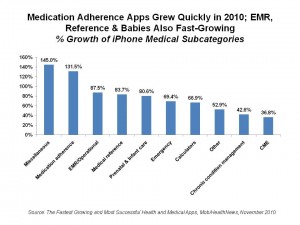“If more than 5 billion people in the world have access to mobile phones (not TVs or PCs), then content delivered to or accessed from mobile phones is the best mass media pick for sharing health information,” asserts a report released in November 2010 from MobiHealthNews, The Fastest Growing and Most Successful Health & Medical Apps.
Overall, health and medical apps grew by 66%. However, growth rates by categories vary: medication adherence, still a small category, was the single fastest-growing category of iPhone health apps between February and August 2010 growing by 131%, followed by three areas with similarly high growth rates in the 80s – EMR/operational, medical reference (a huge category of apps), and apps all-about-babies – prenatal and infant care.
Chronic condition management apps grew at 42.6% — while lower than these other areas, still a respectable rate of growth in the six-month period.
This report follows up MobiHealthNews first analysis of health and medical apps available on the market – most notably in the Apple iTunes Store. I dug into this report in my paper How Smartphones Are Changing Health Care for Consumers and Providers in April 2010, published by the California HealthCare Foundation. The World of Health and Medical Apps report was the first to quantify the types and volumes of health apps available via smartphones, numbering about 4,200 as of April 2010. This new report updates that, and digs deeper into the qualitative aspects of the apps, providing “top ten” lists in each functional area — finding an additional 2,800 health and medical apps.
Applying data from the Pew Internet & American Life Project, the report calculates that about 21 million Americans use at least one health app on their mobile phone. Generally speaking, these apps are more about reference and information than actual management of chronic medical conditions.
The largest categories of apps continue to be medical reference, emergency, infant and prenatal care, and cardio.
Health Populi’s Hot Points: This ever-morphing space is difficult to pin down; the smartphone app/health intersection is evolving by the week, at the intersection of emerging new smartphones/hardware, medical information standards and interoperability, and consumer health engagement.
The untapped opportunities here for engagement are in the areas of chronic health management, broadly speaking, and a sub-category of medication adherence. The latter apps today are largely reminders. This is but one aspect of medication adherence: other aspects that bolster adherence to medication regimens are health benefit design for pharmacy, patient activation and empowerment, and beliefs about the efficacy and side effects for the prescribed treatments. When it comes to medication adherence, it takes a village of health-stakeholders and touchpoints to ‘nudge’ a chronically ill patient to fill a prescription, take the first pill, then sustain that behavior over time. An app can do even more than remind a patient to consume a product: it can incorporate these various touchpoints, from the pharmacy to the health message, the benefit plan and the grocery store shopping list.
For the larger issue of chronic condition management, the phone can be the wellness delivery channel of the future, as coined by Dr. John Mattison, CMIO of Kaiser Permanente. This is a Holy Grail for mobile health – getting people, the most underutilized stakeholder in health, more involved in their own health and health care. With the ubiquity of mobile, and increasingly smart, phones, apps will be a useful tool in the chronic care toolkit…not an ends, but a means.





 I'm in amazing company here with other #digitalhealth innovators, thinkers and doers. Thank you to Cristian Cortez Fernandez and Zallud for this recognition; I'm grateful.
I'm in amazing company here with other #digitalhealth innovators, thinkers and doers. Thank you to Cristian Cortez Fernandez and Zallud for this recognition; I'm grateful. Jane was named as a member of the AHIP 2024 Advisory Board, joining some valued colleagues to prepare for the challenges and opportunities facing health plans, systems, and other industry stakeholders.
Jane was named as a member of the AHIP 2024 Advisory Board, joining some valued colleagues to prepare for the challenges and opportunities facing health plans, systems, and other industry stakeholders.  Join Jane at AHIP's annual meeting in Las Vegas: I'll be speaking, moderating a panel, and providing thought leadership on health consumers and bolstering equity, empowerment, and self-care.
Join Jane at AHIP's annual meeting in Las Vegas: I'll be speaking, moderating a panel, and providing thought leadership on health consumers and bolstering equity, empowerment, and self-care.